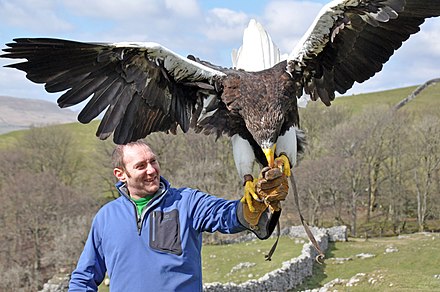Steller’s sea eagles, the largest of all sea eagles, typically lay one to three eggs at a time, with usually only one chick surviving to fledge. These majestic birds are known for their impressive size, impressive hunting skills, and unique nesting habits.
The Nesting Habits of Steller’s Sea Eagles
Steller’s sea eagles are known for their massive nests, which can be up to 100 feet above the ground and contain hundreds of large branches. These nests are typically built high in dead or open-topped trees near rivers or shorelines, or on rocky cliffs.
The female Steller’s sea eagle is responsible for incubating the eggs, which typically take 39 to 45 days to hatch. During this time, the female rarely leaves the nest, ensuring that the eggs are kept warm and protected.
The Eggs and Eaglets of Steller’s Sea Eagles
 Image source: stellers sea eagle
Image source: stellers sea eagle
The eggs of Steller’s sea eagles are greenish-white in color and usually number one to three. However, it is common for only one chick to survive to the fledgling stage, as the other eggs or chicks may not receive enough food or attention from the parents.
When the eaglets hatch, they are born with a soft, white down that quickly changes to a brownish-grey color. It takes approximately ten weeks for the eaglets to fledge, or grow their flight feathers and become capable of flight.
The Lifespan and Maturity of Steller’s Sea Eagles
Steller’s sea eagles are known to live for up to 30 years in the wild. However, they do not reach sexual maturity until they are around five years old. This means that it takes several years for these birds to develop their distinctive black and white plumage and reach their full size and hunting abilities.
The Hunting Habits of Steller’s Sea Eagles
Steller’s sea eagles are primarily fish-eating raptors, with a diet that consists mainly of salmon and trout. However, they are opportunistic hunters and will also consume other sources of protein, such as puffins, crabs, and even deer carcasses when food is scarce.
These birds are known for their impressive hunting skills, which include diving more than 100 feet to catch prey in their powerful talons or swooping down from a perch to snatch their prey. They are diurnal, meaning they are active during the day, and can hunt from a perch or while in flight.
Threats to Steller’s Sea Eagles
Steller’s sea eagles face a number of threats, including habitat loss due to the development of hydroelectric power projects and logging, overfishing, and contaminated rivers. Overfishing has also led to eagles scavenging on carrion filled with lead, which has had devastating effects on the population.
Conservation efforts are underway to protect these magnificent birds, but their future remains uncertain. Understanding the unique nesting and hunting habits of Steller’s sea eagles is crucial to ensuring their continued survival.
Conclusion
Steller’s sea eagles are truly remarkable birds, known for their impressive size, hunting skills, and unique nesting habits. While they typically lay one to three eggs at a time, only one chick usually survives to the fledgling stage. Understanding the biology and ecology of these birds is essential for their conservation and protection.

